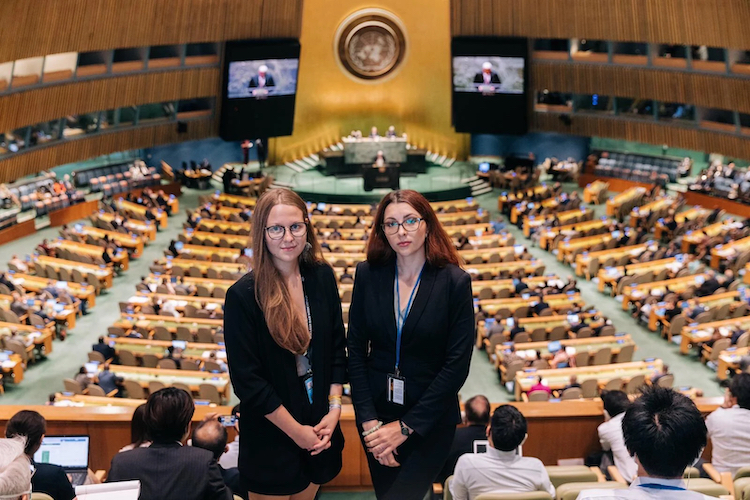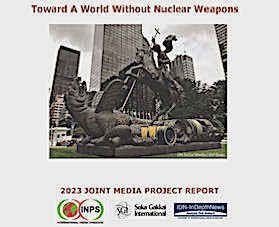Viewpoint by Sergio Duarte
The writer is a former High Representative of the United Nations for Disarmament Affairs (UNODA), and President of Pugwash Conferences on Science and World Affairs.
NEW YORK (IDN) — The Tenth Review Conference of the Treaty on the Non-proliferation of Nuclear Weapons (NPT) takes place in a volatile and unpredictable international context. The danger of the actual use of nuclear weapons was brought vividly to the forefront of international concerns by the invasion of Ukraine by Russia last February. The claim that nuclear weapons have prevented a war in Europe since 1945 has once more been proven false. [2022-08-17]
Although the brunt of the war is being felt in Ukraine, the confrontation between NATO and Russia may spill over its current limits and provoke dire consequences, including what once seemed unthinkable. As the Secretary-General of the United Nations has warned, since the 1962 Cuban missile crisis the world has not been as close to nuclear war as now.
In spite of such ominous prospects, the Review Conference enters its third week in an atmosphere of relative calm as delegations seem ready to start considering draft language for a possible Final Document. The previous Conference was unable to adopt a consensus text at the end of its deliberations in 2015 and most parties to the instrument would be relieved to avoid a second failure in a row. This is, however, easier said than done.
Lack of consensus has been a constant feature since the Eighteen-nation Disarmament Committee (ENDC) started debating a proposal for a non-proliferation treaty jointly submitted in 1965 by its co-Chairs, the delegates of the United States and the Soviet Union. In view of the absence of agreement, in March 1968 the co-Chairs decided to annex their proposed text to a report to the United Nations General Assembly signed by them “on behalf of the Committee”[1].
After long debates, the Assembly adopted Resolution 2373 commending the text of the NPT and requesting its three Depositary governments to open it for the signature of states. The resolution further requested the ENDC to “urgently pursue” negotiations as proposed in Article VI of the instrument.
The Preamble of that resolution states that “an agreement to prevent the further proliferation of nuclear weapons must be followed as soon as possible by effective measures on the cessation of the nuclear arms race and on nuclear disarmament”. Such measures, however, have still to be negotiated in a multilateral context.
Resolution 2373 received 95 votes in favour, four against and 21 abstentions. This result made clear that almost one-fourth of the membership of the United Nations at the time had doubts about joining the NPT. Nevertheless, over the following decades the overwhelming majority of the community of nations gradually became parties to the Treaty, and by 1998 all but four members of the United Nations had joined it.
Several reasons explain the initial hesitation of so many states as well as the subsequent support received by the Treaty. Most countries do not have the necessary scientific and industrial development needed for the development of nuclear activities and relied on the promise of technical assistance for peaceful purposes contained in Article IV. Pressure from nuclear weapon states and lack of incentives to acquire nuclear arms also account for their change of mind.
Others believed that developing their own nuclear capability would be detrimental to their security and entered instead into arrangements with nuclear weapon states for assurances against nuclear attack. Still some others, which possessed significant national nuclear development, hedged their bets until achieving a degree of autonomy in their peaceful programs and finally decided to join the Treaty. Today the NPT is the most adhered to instrument in the field of disarmament and non-proliferation.
Nevertheless, the main points of disagreement not resolved at the ENDC periodically come back to haunt the parties. These issues stem from the inherent imbalance between the rights and obligations of nuclear and non-nuclear parties and from the primacy given by the nuclear weapon states and their allies to measures of non-proliferation over disarmament.
While non-nuclear parties have consistently called on nuclear-armed states to fulfill the obligation of moving toward disarmament contained in Article, VI, the latter have always conditioned action to that end to ill-defined improvements in the world security situation, generating a deeply-rooted sense of frustration in the non-nuclear parties. That difference of perceptions has been the main obstacle to consensus at Review Conferences, a result that has eluded the parties to the NPT in five out of nine such Conferences so far.
Other important questions still subject of disagreement since the early debates on the implementation of the Treaty include efforts to increase restrictions and impose conditionalities on peaceful nuclear programs of non-nuclear states in contrast with the reluctance to accept binding disarmament commitments as the arms race among those that possess such weapons accelerates.
In fact, the latter seems to interpret the Treaty as granting them not only a license to forever keep their nuclear arsenals but also a free hand to improve the speed, accuracy and destructive power of such armament in what can be characterized as technological proliferation.
The question of “nuclear sharing” has never been satisfactorily settled and now threatens to reappear in the context of divergences between Russia and the United States.
Lack of progress in the establishment of a zone free of weapons of mass destruction in the Middle East—a condition for the indefinite extension of the NPT won by the nuclear parties in 1995—is a recurrent complaint that has prevented consensus in previous NPT Review Conferences, as was the case in 2005 and 2015.
The recent announcement of a partnership among the United States, United Kingdom and Australia to build a fleet of nuclear-powered submarines is also the subject of controversy. While the acquisition of naval nuclear propulsion does not run counter to the NPT and is actually provided for in the standard IAEA comprehensive safeguards agreements, the transfer of nuclear material for propulsion, in particular highly enriched uranium (HEU) has given rise to concerns.
China, for one, raised the prospect of nuclear weapons proliferation in the Pacific and Indian oceans, while Australia and its partners contend that adequate safeguards can prevent that possibility. Other countries also have an interest in this matter, and there are significant differences between specific programs.
The advent of the Treaty on the Prohibition of Nuclear Weapons leading to their elimination (TPNW) added another element to the panoply of issues that can derail the 10th Review Conference. At its adoption in 2017, the five nuclear weapon states recognized by the NPT set forth their view that it is “counterproductive” and “incompatible with the NPT” and declared their intention never to sign it.
For their part, the 62 parties and 86 signatories of the TPNW seem determined to include a reference to the complementarity of new Treaty with the NPT in the final result of the NPT Review Conference. They argue that its negotiation stems directly from the call of Article VI of the NPT for each party to “undertake negotiations in good faith on the cessation of the nuclear arms race and nuclear disarmament”, in accordance with Resolution 71/258 by a United Nations conference open to all of its members, which the nuclear weapon states and all but one of their allies dec lined to attend.
All parties to the NPT have a stake in the success of the Tenth Conference. In spite of their deep differences, the nuclear powers have so far exercised enough restraint in their participation in the debates to prevent the current heightened mistrust and animosity among themselves from negatively affecting the proceedings, as was the case in previous instances. However, given the degree of dissatisfaction of a large section of the membership over the lack of fulfilment of the central bargain of the Treaty—non-proliferation versus nuclear disarmament—, it is today far from certain that the parties will be able to find consensus formulations for a Final Document.
As noted above, such a development is not unprecedented and should not discourage the members of the NPT from continuing to search for common understandings on nuclear non-proliferation and disarmament. The existing regime is certainly not the only reason why so many countries have decided not to obtain such awesome means of destruction, but its contribution to peace and stability cannot be understated. It is important, however, to understand that the international situation has evolved since the inception of the NPT.
As it stands now, the regime seems outdated and unable to provide meaningful answers to the concerns of the international community about its own survival. Even so, calls for en masse abandonment of the Treaty did not raise much enthusiasm among the membership[2].
These considerations should be in the minds of delegates to the 10th Review Conference as they embark on the final stretch of their deliberations. [IDN-InDepthNews – 17 August 2022]
Photo: Two young Ukrainian voices, Yelyzaveta Khodorovska and Valeriia Hesse delivered a statement on behalf of ICAN calling for nuclear disarmament at the NPT Review Conference. Source: Arms Control Association.













